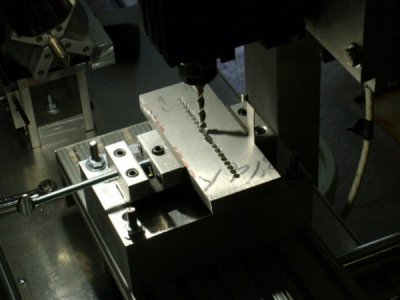- Joined
- Nov 24, 2013
- Messages
- 268
I want to cut the slot shown on the attached and I’m not sure if it’s ok to plunge slowly straight down in several passes and if the end mill I have is the proper one.
The aluminum bar is 2”x5.5”x0.5” thick, the slot is 4.24” long (should go down to 0.5” deep), the end mill is 2 flute, 0.25” OD, 3/8” shank. I have a piece of pressboard under the bar to avoid damage to the vice,
I have drilled the holes shown in the slot to speed up the milling time; they all are with a 7/32” drill except the 2 in the center are with a 17/64” drill. I was thinking to lower the end mill to a 17/64” hole and then move the axis left / right to complete each pass.
Do you have any suggestions?

The aluminum bar is 2”x5.5”x0.5” thick, the slot is 4.24” long (should go down to 0.5” deep), the end mill is 2 flute, 0.25” OD, 3/8” shank. I have a piece of pressboard under the bar to avoid damage to the vice,
I have drilled the holes shown in the slot to speed up the milling time; they all are with a 7/32” drill except the 2 in the center are with a 17/64” drill. I was thinking to lower the end mill to a 17/64” hole and then move the axis left / right to complete each pass.
Do you have any suggestions?

